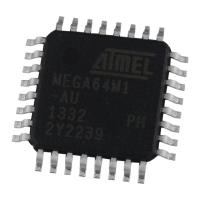204
7647H–AVR–03/12
Atmel ATmega16/32/64/M1/C1
17. LIN / UART - Local Interconnect Network Controller or UART
The LIN (Local Interconnect Network) is a serial communications protocol which efficiently sup-
ports the control of mechatronics nodes in distributed automotive applications. The main
properties of the LIN bus are:
•
Single master with multiple slaves concept
• Low cost silicon implementation based on common UART/SCI interface
• Self synchronization in slave node
• Deterministic signal transmission with signal propagation time computable in advance
• Low cost single-wire implementation
• Speed up to 20 Kbit/s.
LIN provides a cost efficient bus communication where the bandwidth and versatility of CAN are
not required. The specification of the line driver/receiver needs to match the ISO9141
NRZ-standard.
If LIN is not required, the controller alternatively can be programmed as Universal Asynchronous
serial Receiver and Transmitter (UART).
17.1 LIN Features
• Hardware Implementation of LIN 2.1 (LIN 1.3 Compatibility)
• Small, CPU Efficient and Independent Master/Slave Routines Based on “LIN Work Flow Concept”
of LIN 2.1 Specification
• Automatic LIN Header Handling and Filtering of Irrelevant LIN Frames
• Automatic LIN Response Handling
• Extended LIN Error Detection and Signaling
• Hardware Frame Time-out Detection
• “Break-in-data” Support Capability
• Automatic Re-synchronization to Ensure Proper Frame Integrity
• Fully Flexible Extended Frames Support Capabilities
17.2 UART Features
• Full Duplex Operation (Independent Serial Receive and Transmit Processes)
• Asynchronous Operation
• High Resolution Baud Rate Generator
• Hardware Support of 8 Data Bits, Odd/Even/No Parity Bit, 1 Stop Bit Frames
• Data Over-Run and Framing Error Detection

